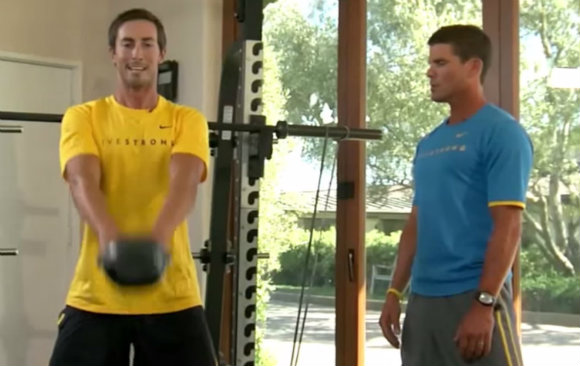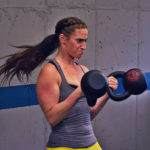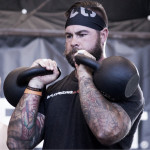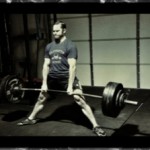Peter Park has trained many professional athletes, most notably endurance athletes like Lance Armstrong. While many endurance athletes continue to be overly-concerned with more and more “endurance” training at the expense of strength training, Peter understands the importance of strengthening the endurance athlete. His strategy is explained below.
The strength techniques I use with my endurance athletes today have evolved 180 degrees from the way I trained myself as a professional triathlete thirty years ago. Back then, I would go into the gym two to three days per week, do 15-20 reps of squats, lunges, box jumps, push-ups, pull-ups etc. in circuit format as fast as possible. I was more concerned about keeping my heart rate and endorphins high than any real benefit to my racing.
My training partners and I were the envy of the gym for how “fit” we were, but little did I realize, I was basically going in the gym and doing the exact same workout, and using the exact energy systems as I was when swimming, cycling, and running.
Today, I train athletes with a mixture of my own experimentation and experience, along with elements picked up from incredible mentors like Pavel, Phil Maffetone, Lance Armstrong, and many others. Although I train athletes in all sports, I am best known for my work with endurance athletes, such as cyclist Lance Armstrong and motocross legend Chad Reed.
Most of my endurance athletes have long competitive racing seasons. A typical race calendar for an Ironman triathlete, for example, will go from April to mid-October. There is no possible way an athlete can stay sharp or peaked for that long a period of time. Therefore, I set an athlete’s season to peak once in May and early June, then again in September and early October.
A Basic Sample Schedule for an Ironman Triathlete
- End of October and November: off-season
- December to end of March: base training, higher volume strength training
- April to mid May: interval training, lower volume strength training
- June to late July: peaking for early season Ironman, easy strength
- Late July to End of August: base training, higher volume strength work
- September to early October: peaking for seasons key race (Ironman Hawaii), lower volume, higher intensity strength work
Off-season is a time to shut the factory down, reflect, reorganize, and plan for the next season. I have found that six weeks is about the perfect amount of time for the off-season. My clients will stay active doing activities such as trail running and mountain biking, but nothing structured and only when they feel like it. I recommend most athletes stay out of the gym during this brief period — I want them to refresh the body and mind to be ready to get after it when the time comes.
The base training period is the most important cycle of the season. If done correctly, it sets the framework and foundation for a successful race season. If done poorly, mediocre results and often frustrating injuries result.
Nutrition for Endurance Athletes
Training and nutrition take on symbiotic roles in this stage. The two programs are equally important and dependent on each other for success.
Nutrition-wise, I have had the most success with clients following a low carbohydrate (for an endurance athlete), high fat, and moderate protein diet during the base period. I recommend keeping the carbs to about 100 grams (give or take) for the entire base period.
The purpose is to force the body to shift to using fat for its primary energy source instead of carbohydrates. With little glycogen available, the body is forced to get the fatty acids mobilized from fat stores to be used for energy. When I see a client at the end of this period eat a breakfast such as eggs, bacon, and some avocado, do a three- or four-hour ride with only water, and have no blood sugar issues, I know they have become the fat-burning machine I want.
Cardio During the Base-Building Period
All the cardio training during this period is performed at aerobic heart rate. The purpose is to get your aerobic system as efficient as possible. In a nutshell, you are looking to increase the production of mitochondria in muscle cells. Doing this longer, lower-level aerobic training builds more mitochondria and capillaries for better fat mobilization and oxygen transport to muscles.
I still use Phil Maffetone’s 180-[age] formula to get the athlete’s max aerobic pace. For example, if you were thirty years old, your max aerobic rate would be 150 (180-30). All workouts stay in this heart rate range. I will still do various types of interval training in this period, but all under the prescribed heart rate.
People are often frustrated at first about how slow they have to go to stay under the required rate. It takes a lot of patience and willpower, but the results are remarkable. It is not uncommon to see a three-mile running time trial be five to seven minutes faster at the same heart rate at the end of a base-building period.
Strength Training for Endurance Athletes
The base period is also the time where strength training can be maximized. With the cardio being done at a lower intensity, I ramp up the strength work during the base period. I will generally have clients strength train three days a week: Monday and Friday are the heavier, more intense days, while Wednesday’s workouts are lower in intensity and may include single leg work, explosive work such as hill bounds, and kettlebell complexes.
Reps are kept in 2-5 ranges on the main lifts, the 5-10 range with assistant work. Volume varies from week to week, but generally 10-12 working reps for my main lifts. Tuesday, Thursday, and Saturday I will prescribe a short program of correctives and mobility to do on their own.
 I use a variable load schedule with both the cardio and the strength work. Some weeks, I will emphasize the mileage in the cardio, and cut back on the volume and intensity on the strength side. Other weeks, I may reverse it, and up the intensity and volume in the strength, and cut back on the cardio training. I also make sure to demand a recovery period every three or four weeks, dropping volume considerably in both cardio and strength.
I use a variable load schedule with both the cardio and the strength work. Some weeks, I will emphasize the mileage in the cardio, and cut back on the volume and intensity on the strength side. Other weeks, I may reverse it, and up the intensity and volume in the strength, and cut back on the cardio training. I also make sure to demand a recovery period every three or four weeks, dropping volume considerably in both cardio and strength.
Every athlete is different in how much volume and intensity they can handle. It is my job to make sure the athlete is progressing and absorbing the training. It is far better to be slightly undertrained, than overtrained.
A typical strength program during the base period:
Warm up: 2 x
- Goblet squats
- Hip thrusts with barbell or dumbbell
- Halos
- Empty Olympic bar overhead squat to side lunges
Circuit 1: 3 x 4 reps ( 75-80% effort or 4 with 2-3 left in tank): heavier deadlifts Monday and heavier squats Friday.
- Deadlifts
- One arm kettlebell press
Circuit 2: 3 x 4 reps ( 75-80% effort or 5 with 2-3 left in tank)
- Zecher squats
- Pull-ups
Circuit 3: Quicker pace holding form: wear heart rate monitor and stay under prescribed rate. 2-3 x
- Push-ups: as many as possible with perfect tight form
- Swings: 10-15 reps
- Renegade row: 7 per side
- Swings: 10-15 reps
Core: 2 x
- Get-ups: 1-2 per arm
- Farmer walks
- Stir the pots
On a side note, the program will vary depending on the type of endurance athlete I am working with. For example, triathletes and motocross athletes can afford and need to have some upper body strength to compete in their respective sports. A Tour de France rider, like Lance, or an elite marathon runner, needs to be careful about having too much weight upstairs. In fact, with Lance, our goal was achieving the core strength of a gymnast, the leg strength of a powerlifter, and the upper body size of a twelve-year-old girl! Strength-to-weight ratio is huge in pro cycling and marathon running. Therefore, when designing an endurance athlete’s program, you need to be careful with your exercise selection.
How Training Changes in April
When April rolls around, my athletes are strong, fat-burning machines, and more than ready to start some quality speed sessions. We will do some training races in May and early June, then a scheduled peak race in late June. It always surprises me how few speed workouts an athlete needs if the base training was done correctly. The aerobic system is so efficient, three to five key workouts or races are all that is needed to reach a peak.
The higher intensity speed work will eat up glycogen levels. Therefore, I will advise my athletes to increase carbohydrate intake by 60-100 grams for every high intensity hour of training.
During this period, I cut the strength training to two days per week. Both the volume and intensity in this phase is decreased. It is very much like Pavel and Dan John’s Easy Strength philosophy of training in season. Get in some quality work, never train to failure, and finish completely unfatigued and able to attack any workout your sport requires.
I try to schedule the strength workouts the evening after the cardio speed workouts. I prefer this method to give the athlete adequate recovery in between the high-end intense days. The strength workouts will continue until about two weeks before the peak race. At this point, the work is done and the goal is to do just enough work to stay sharp for race day.
A typical strength program during the peaking phase:
Active warm-up: 10 min of goblet squats, bridges, leg swings, etc.
Short reactive work:
- Hill bounds
- Eccentric swings or snatches
Circuit 1: 2-3 sets
- Deadlifts: 3 sets of 2-3 reps 70-75% of max. moving bar quick
- Kettlebell push press: 3-5 reps explosive
Circuit 2:
- Front squats (kettlebell or barbell): 2-3 reps 70-75% of max. explosive
- Pull-ups or medicine ball slams
Core work:
I will do a short circuit here that may consist of get-ups, farmer walks, and various planking or rotational and anti-rotational work.
Occasionally, I will add in a few assistance exercises if no races are planned for the weekend. After the peak race, I will give the athlete a six-week mini off-season to rejuvenate and recover. From here, it is back to base training and heavier strength work for six weeks or so to build to the next race.
Training Endurance Athletes Effectively
I hope this article gave the StrongFirst reader some insight on how an endurance athlete trains, and more specifically, how strength work is implemented in the overall program. I have always believed strength training to be a huge part of an endurance athlete’s program, not only for performance, but also for longevity and injury prevention. I will continue to fine-tune my methods, and look forward to sharing them here.







Fantastic article thanks for sharing you knowledge. Would you consider a Motocross racer to be an endurance athlete? as we are only doing an average of 2-3 30min racers per day, and would you recommend the low carb/ high fat/ high protein diet for us Motocross riders? As well as the training techniques above or would you suggest a different approach?
Thanks again
I want to develop a weigh training program that I can do during my aerobic training period (180-age). Do I understand Maffetones guidelines to mean that you never want to exceed your 180-age HR during any of your lifting workouts?
Thanks for the great info! Really excited to see you mentioned motocross racer Chad Reed. I’m a lifelong racer and fan and it takes incredible strength and endurance to race motocross at a high level! Going to read this over a few more times and try and integrate some of it into my MX program.
You mention core work as rotational and anti-rotational. Could you give some example exercises?
thanks
More information on the formula can be found at the following. Note the emphasis on calculating physiological versus chronological age. As always, it’s the details that matter most.
http://philmaffetone.com/180-formula
Love the strength stuff. totally agree! this exact methodology has paid off huge dividends to me personally in my racing (especially cycling).
Not a fan of the max aerobic HR calculation. HR zones are so variable that 180-age is bound to be off for quite a few people.
Paul, why not test the athlete instead to get a more accurate number?
I’m still undecided on the max aeobic theory. there have been some anecdotal reports of athletes having success with it, such as mark allen, but why do virtually zero world class coaches use it in training the best athletes in the world? renato canova, steve magness, etc. Those guys periodize for sure, but they use high intensity and low intensity year round.
Peter,
Great article. In your cardio section you say you do various types of interval training but still stay below the 180-age HR. Have I mis-read that? When I try to stick below 180-age (41) it feels slow – fine for long aerobic sessions (jogging / rowing) but I can’t imagine how I could keep an interval session under 139 bpm and feel much benefit. COuld you provide a bit more detail on your interval work?
Many thanks
Karl
I think the general concept is that you continue to train at your aerobic level until you start reaching speeds that are almost uncomfortable to maintain (e.g.g mark alleys aerobic pace at 150bpm was something like 5min 10 miles very fast!). At that point and at that level of fitness you may want to do aerobic intervals say over a half hour period where you do 7 to 10 second intervals at your race pace then ease down for 2 mins and continue in that vain for 30mins to an hour. This allows your body to acclimatise to race pace but with minimal stress on your body. It can also be employed if you haven’t reached a fast aerobic speed but is only recommended nearer to a race to minimise stress. if you are still making progress with aerobic training, it makes sense to continue with your aerobic conditioning as anaerobic exercise can interfere.
Paul is exactly right. I also like to do downhill ( slightly ) intervals, you can still stay aerobic but get the leg speed of anaerobic training.
To do this program, you have to be extremely patient. The first month or so will be very difficult and will screw with your ego. But, if you hang in there and get through the sticking point the results will quickly follow. You may not be efficient enough aerobically for the first few months to do intervals. Many start with almost 11 min miles being their high end aerobic pace, which is almost walking for some. I remember seeing some of the top pro triathletes walking up hills running, and weaving back and forth on the bike to stay in zones at first. But after a few months your going a good clip at same heart rate.
I have seen same thing with a few general fitness clients I have put on this program. I will do a test with swings: usually 10 sets of 10-12 with a moderately heavy weight. At the beginning, to keep heart rate at required rate they will have to rest sometimes close to a minute. Two months later they can go almost with 15 -20 sec rest and push hard.
My age is against me. I can confirm that using my rowing machine and trying to keep my heart rate <139 is definitely screwing with my ego!
I'll persevere with it for a month and see if my splits come down.
Peter may be able to answer this better than me, but I wonder if aerobic activities that use your arms may mean it’s very hard to stay in the zone due to the differnece in levels of aerobic muscle in the upper body. When I first started training with the 180 formula I was only doing 13 min miles. Bloody ell it killed me. I was walking on flats after a couple of miles. Took one year of solid training to get to 8 min 10 miles. But my fitness and body fat percentage (plus general energy levels) improved dramatically.
Nobody cares what Lance Armstrong does/did. It’s strange you mentioned this disgrace of a human so much in your article, yet casually only mentioned once you trained the great Chad Reed. Now, that gets my attention. Though riding two 30 minute motos at full output at such an amazing skill level requires tremdous endurance, the strength levels required blow the doors off what any pansy bicyclist or ironman competitor would be using. I’d really like to hear more about the training program you used for Chad?
I for one care, do no tmake the misstake that “your opinions” = “all others opinions”.
Lance Armstrong is one of the best examples of a athlete and professional there is. All his accomplishments in and outside the world of cycling are there at top of my list all time.
This article is spot on, top notch! More like this please!
Very well said Joel
Yeah I would have preferred to listen about anyone else.
A disgrace for being caught using PEDs? Seems a bit naive to believe anyone at that elite level isn’t taking PEDs of some kind.
It wasn’t just the PEDs Shawn. Read up, it is not hard to find the rest of what he did, but in protecting his secret (and thus $$), he pressured companies to not hire people, he really screwed over lots of people.
Thanks for this great article that shows how you use strength development for your endurance athletes. I have a question for you, because I relate very much to your 180degrees change in your training along the years, and particularly using the Easy Strength training system.
I’ve been a tennis pro and coach young players who want to become Champions. I ve started to use the strength training a while ago and see amazing results on the court.
Now, my question is about the cardio development.
As far as I understand, Pavel and Dan recommend to do 80% of your time your sport, 10% strength and 10% development of specific skills. And I get that the cardio or “conditioning” occurs within the training of our sport.
Having said this, I feel I can refine my training in this area, which is, basically, not thinking about it much and focusing on what I feel the person needs at that moment (technique, strategy, mental toughness…etc).
What I would like is to have a baseline to work with regarding the conditioning part.
Here you’re talking about interval training and staying to the 180-age frame.
Is there a reference or something to look at that you could advise to me for this conditioning development? I really love the Easy Strength philosophy and I wonder if there is an Easy Endurance’s one. I’m aware there is the Crossfit possibility, but I don’t think it’s easily applicable if i want to have my students fresh for playing tennis. Unless I’m doing like you with emphasising on one quality while diminishing the one on another quality.
Ok, thanks for your attention. I’m not sure my question is clear, maybe because I’m not totally clear, so whatever answer you give me would be perfect, thanks! And thanks for this article, love it!
Benoit
Brilliant Peter, great to see such a comprehensive article on how strength and endurance work as one. I’ve mentioned maffetone on this site before and it’s great to see strong first leading the way with accurate information on the marriage of endurance and strength. There’s so much misinformation.
Maffetone changed my life in terms of fitness and I spend over a year using the 180 formula and followed his two week test to great results. Finally since a single visit to a physio who pointed to a kettlebell ive followed the hard style pavel approach. Both training philosophies follow paths in the same direction. Exciting stuff.
Any reference you would advise for Maffetone principles, Paul?
Thanks,
Benoit
Phil Maffetones book (The Big book of endurance and Racing) is the go to book (like enter the kettlebell). As you mentioned in your post above, if you want Easy Endurance then this is the Book!
Phil also recommends strength work in the form of ‘Slow Weights’ which is very much like gtg or easy strength.
This book covers everything you’ll need (he’s latest is on the 1.59 marathon, but is not a training guide)
http://www.amazon.co.uk/Big-Book-Endurance-Training-Racing/dp/1616080655/ref=sr_1_1?s=books&ie=UTF8&qid=1427888836&sr=1-1&keywords=big+book+of+endurance+training
Thanks Paul, this is awesome!
Blessings,
Benoit